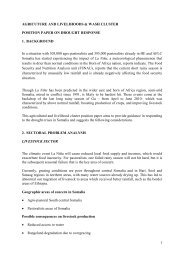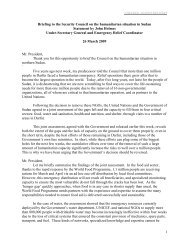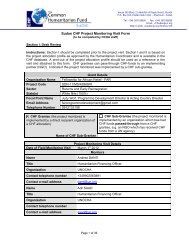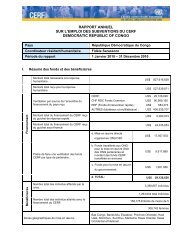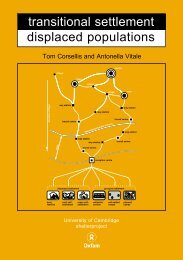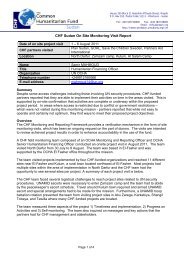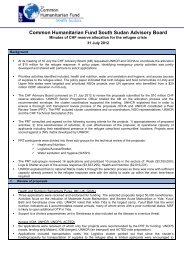Shelter - NFI SPHERE - OCHANet
Shelter - NFI SPHERE - OCHANet
Shelter - NFI SPHERE - OCHANet
You also want an ePaper? Increase the reach of your titles
YUMPU automatically turns print PDFs into web optimized ePapers that Google loves.
Minimum Standards in <strong>Shelter</strong>, Settlement and Non-Food Items<br />
maximise the use of existing or repaired facilities whilst minimising the<br />
adverse effect on any neighbouring or host communities. Additional facilities<br />
or access points should be provided as required to meet the needs of<br />
accommodating the target population, and planned to ensure safe access<br />
by all inhabitants. The social structure and gender roles of the affected<br />
population and the requirements of vulnerable groups should be reflected in<br />
the planning and provision of services. Safe play areas should be made<br />
available for children, and access to schools and other educational facilities<br />
provided where possible (see Water Supply, Sanitation and Hygiene<br />
Promotion chapter on page 51 and Health systems and infrastructure<br />
standard 5, guidance note 1 on page 267).<br />
3. Handling the remains of the dead: social customs for dealing with the<br />
remains of the dead should be respected. Where customs vary, separate<br />
areas should be available for each social group to exercise their own<br />
traditions with dignity. Where existing facilities such as graveyards or<br />
crematoria are inadequate, alternative locations or facilities should be<br />
provided. Graveyards should be at least 30 metres from groundwater<br />
sources used for drinking water, with the bottom of any grave at least 1.5m<br />
above the groundwater table. Surface water from graveyards must not<br />
enter inhabited areas. The affected community should also have access to<br />
materials to meet the needs for culturally acceptable funeral pyres and other<br />
funeral rites (see also Health systems and infrastructure standard 5,<br />
guidance note 8 on page 269).<br />
4. Administrative facilities and quarantine areas: as required, provision<br />
should be made for administrative offices, warehousing and staff<br />
accommodation to support disaster response activities, and for quarantine<br />
areas (see Control of communicable diseases standard 4 on page 279).<br />
5. Surface area: the planning guideline of 45m 2 per person includes<br />
household plots and the area necessary for roads, footpaths, educational<br />
facilities, sanitation, firebreaks, administration, water storage, distribution<br />
areas, markets and storage, plus limited kitchen gardens for individual<br />
households. Area planning should also consider evolution and growth of the<br />
population. If the minimum surface area cannot be provided, consideration<br />
should be given to mitigating the consequences of higher-density<br />
occupation e.g. separation and privacy between individual households,<br />
space for the required facilities, etc.<br />
<strong>Shelter</strong><br />
217




